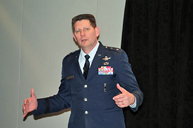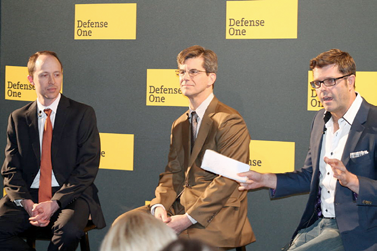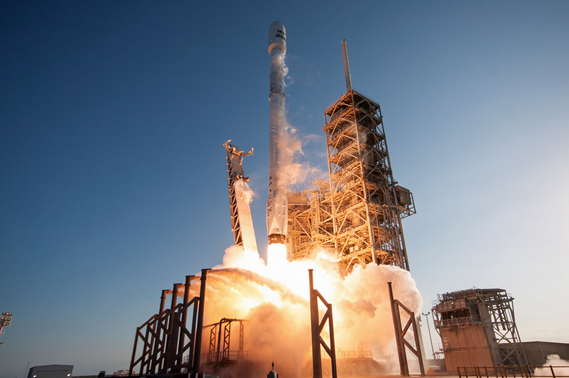During March of this year, the Government Satellite Report team had the opportunity to attend the Washington D.C. satellite show.

The conference brought together satellite executives, aerospace thought leaders and end-users — including government and military satellite decision makers — to discuss advancements in satellite technology and share best practices.
However, even with a solid list of speakers and attendees, one of the most interesting and telling quotes I heard at this year’s conference was spoken by someone that may not have even been in attendance – Tech Sergeant Justin Perran of the United States Air Force.
TSgt Perran is a Joint Tactical Air Controller, a position which requires him to use satellite capabilities to ensure that the actions of fixed and rotary wing support aircraft are as precise as possible.
As Major General David D. Thompson, the Vice Commander of Air Force Space Command, explained, “[TSgt Perran’s] job — in essence — is to be a scheduler. He schedules meetings between our enemies and American firepower. And he does it continuously. He is the most lethal person on a battlefield.
"Our adversaries have been watching as well and they recognize now what space does for the American way of war — the precision, the lethality and the effectiveness — and they’ve decided that it’s time to take that advantage away from the United States.”
I can only speculate about TSgt Perran’s whereabouts during the show as I never came face-to-face with him, or bumped into him. He wasn’t a keynote speaker or — as far as I can tell — even a panelist during the event. But he was the star of a video package that was aired when General Thompson got up to speak.
What Tsgt Perran said in that video perfectly and beautifully encapsulated everything those listening will ever need to know about the importance of satellite to today’s modern warfighter.
Speaking about GPS and satellite capabilities, TSgt Perran said, “No, I don’t want to be in a fair fight. The advantage is that America’s military is so well trained and equipped that even if you took everything away, we’re still better than [our potential adversaries]. But, when you add all of the capabilities that we have, and add all of the technology, and you get me down to that five minute window, that’s absolutely what I’m going to prefer. That’s because we’re going to win that fight and we’re going to win it so fast that you’re not even going to know what happened. All of my guys are going to be safe and you’re not going to send anymore because you know you’re just going to lose them.”
That’s the kind of confidence that Maj. Gen. Thompson is looking to instill in the warfighter, which he refers to as his, “customer.” That confidence comes from ensuring that space capabilities are there when they’re needed for the soldiers in theater. According to the General, “It’s our job to ensure that those capabilities are there, on time every single time.”
But Maj. Gen. Thompson’s job — and the job of everyone in Air Force Space Command — is only getting harder. Ensuring space capabilities for the warfighter isn’t as easy as it was in the past, when space was an uncontested domain that could be utilized to the advantage of the United States and few others.

Major General Thompson, Air Force Space Command.
Today, the space domain is changing, and that change was very well articulated by Maj. Gen. Thompson, when he said, “Our adversaries have been watching as well and they recognize now what space does for the American way of war – the precision, the lethality and the effectiveness – and they’ve decided that it’s time to take that advantage away from the United States. It’s only recently that it’s become obvious – not just to us but to the rest of the world – that others intend to deny us that capability in the future.”
This shifting and changing threat environment in space is forcing the Air Force and Department of Defense to make changes as well — both as to how they operate in space, and how they construct their satellite architecture and infrastructure.
When it comes to operations and the command and control of space assets, the Air Force is fundamentally reevaluating the role of its airmen and examining what their highest priority and highest value tasks should be. In the past, this included the actual management and command of spacecraft in orbit, but there seems to a shift in that mindset.
Maj. Gen. David D. Thompson added, “…we’re going to increasingly look at the ability to bring commercial and contract operators online to do the routine day-to-day flying and operations for our satellite constellations while we focus on what we are truly commissioned and designed to do, which is fight [adversaries] through a contested environment.”
As Robert Tarleton, Jr., the Director of the MILSATCOM Systems Directorate, Space and Missile Systems Center, Air Force Space Command, discussed in a previous post on the Government Satellite Report, there is an RFP that positions industry partners and contractors to take over the command and control of the military’s WGS and DSCS satellite constellation. This step would free up existing airmen to focus on the higher value tasks increasing space situational awareness, understanding the threat environment and actually countering adversary attacks on space assets.
This shift in responsibility was well illustrated by Maj. Gen. Thompson, when he said the following, “For years we have been focused on keeping the trains running on time. Our job now is to understand the threat environment and be able to react to it, and – in order to do that in this current environment – we will not get more uniformed or civilian airmen to do that. So, we’re going to increasingly look at the ability to bring commercial and contract operators online to do the routine day-to-day flying and operations for our satellite constellations while we focus on what we are truly commissioned and designed to do, which is fight [adversaries] through a contested environment.”
The other change involves how the military builds its space architecture. The increasingly contested space domain means that operational resiliency is essential to ensure space capabilities aren’t compromised.
By distributing and proliferating systems across additional satellites — including those of allied nations and commercial partners — the military can ensure that an attack on any single satellite no longer impacts service delivery.

According to Maj. Gen. Thompson, “A diversity of options that are space based…will also make for more resilient architecture….Increasing the distribution of [systems] in the SATCOM world and the diversity across bands, across capabilities – both military and commercial – will help us increase the resiliency of those systems as well.”
To accomplish this diversity and increase resiliency, the General proposed increased use of COMSATCOM services, as well closer partnerships with the COMSATCOM industry.
Maj. Gen. Thompson suggested that the military look to the COMSATCOM industry for innovative ideas and solutions to the military’s problems. He also discussed a consortium of commercial and industry partners that work together, as well as compete, to come up with innovative new satellite technologies and solutions for the military.
According to Maj. Gen. Thompson, the Air Force needs to, “…recognize the commercial capabilities that are out there…also the commercial ideas for how to operate and field systems and deliver capabilities to our customers.”
Additionally, during this trade show in D.C., SES Government Solutions partnered with Defense One to sponsor an interesting Cocktails and Conversations event entitled, “Space and Satellite in the New Administration.”
Although the event didn’t focus extensively on President Trump and his administration’s impact on space policy, it did bring together senior military space decision makers and satellite industry experts to discuss the future of the US government’s space infrastructure and the constantly-evolving challenges impacting our space assets today.
Participants in the panel discussion included:
• John Hill, the Acting Deputy Assistant Secretary Of Defense For Space Policy at the Department Of Defense (DoD)
• Todd Harrison, the Director of the Aerospace Security Project and Director of Defense Budget Analysis at the Center For Strategic And International Studies
• Patrick Tucker, the Technology Editor at Defense One and panel moderator

The conversation began with a discussion of the GPS satellite constellation and how it’s become so essential for the US military, effectively enabling previously unthinkable levels of precision when it comes to targeting adversaries and tracking friendly troop movements.
With this constellation so important and mission-critical to today’s military, discussion almost immediately shifted to protecting the constellation in today’s much more contested space domain and environment.
The panelists noted that the GPS constellation has some benefits that not every military satellite constellation has. Namely, the constellation — by its nature — degrades gracefully, and there is baked-in resiliency since there are more satellites in the constellation than currently needed. This helps make the constellation more resilient and makes it more difficult to compromise the capabilities it delivers.
They also discussed how utilizing other, similar signals and constellations — such as the Galileo global navigation satellite system — could increase this resiliency even more.
This sentiment was echoed by Mr. Hill, who said, “With GPS, you have a distributed capability, it’s also a proliferated capability. It’s distributed in that you only need four satellites out of the 24 from the constellation to get your signal. But it’s also proliferated in terms of the number of satellites we have up there because these things have a way of not dying. The proliferation takes away the incentives of someone trying to destroy them kinetically.”
John Hill then added, “[We have] to recognize the point, as technology evolves and democratizes — maybe even commoditizes — that there are pieces of it where the commercial demand - the commercial market - starts driving the innovation.
“[We have] to recognize the point, as technology evolves and democratizes — maybe even commoditizes — that there are pieces of it where the commercial demand – the commercial market — starts driving the innovation.”
But resiliency isn’t necessary in just navigation. There are many capabilities that the United States military gets from space and satellites, and these satellites — including communications satellites — need to be up and available for the warfighter on the battlefield with the same reliability as the GPS constellation. In this area, the resiliency that is inherent with the GPS constellation can be a best practice.
Distributing a satellite signal across multiple satellites, and proliferating the number of satellites that can be used to carry a signal, are both effective ways to eliminate an adversary’s ability to compromise the capability they deliver.
Mr. Hill illustrated that point when he said, “What can I do to reduce the incentives to attack a constellation? I would just assume take the thought out of [an adversary’s] mind because they realize that it’s not going to work since the Americans have multiple approaches to this.”
But the military’s SATCOM constellation doesn’t have the baked-in resiliency that the GPS constellation does. There simply aren’t enough MILSATCOM satellites in the WGS constellation to replicate the level of resiliency that exists in the GPS constellation.
However, there are enough commercial satellites in orbit across all of the disparate COMSATCOM providers and satellite operators to deliver this resiliency to the military.
By increasing the use of COMSATCOM services from its industry partners and providers, the military can effectively replicate the level of resiliency it enjoys with the GPS constellation for its communications satellites. It can even replicate the desired effect of diversifying navigation signals by using other constellations, such as Galileo, by relying more heavily on COMSATCOM providers.
But the benefits of partnering with the satellite industry don’t end at resiliency and redundancy. There is also the benefit of harnessing private industry’s innovation and technologies.
The discussion at the Defense One event took an interesting turn when the panelists began comparing the capabilities of private industry and the federal government. What they concluded was that the private space industry has shifted gears and sped past the federal government when it came to innovating new space capabilities and technologies.
According to Mr. Hill, “[We have] to recognize the point, as technology evolves and democratizes – maybe even commoditizes – that there are pieces of it where the commercial demand – the commercial market – starts driving the innovation. The trick for the DOD is to figure out…where we have ceased to be the innovator and driver, and the commercial side is now that – and how do we capture that and bring it in.”
Noting that the end user — the warfighter — doesn’t necessarily care where their capabilities come from, or who delivers them, just that they work when they’re needed, the panelists agreed that COMSATCOM usage should increase.
By leveraging COMSATCOM more aggressively, the military can get access to more bandwidth and deliver more capabilities quickly, while also taking advantage of the advanced technologies that the industry is
already embracing.
"The trick for the DOD is to figure out…where we have ceased to be the innovator and driver, and the commercial side is now that - and how do we capture that and bring it in,” said John Hill
In order to accomplish this, COMSATCOM services need to become more integrated into the military’s wider
SATCOM architecture.
Hill added, "We need to figure out how to better take advantage of what everyone else is doing better in space. How do you incorporate the commercial system into your architecture and do it as a more natural part of your process? How do we look at what’s happening in the commercial communications area — with GEO, MEO and LEO — and how do we architecturally think about using all of those things in a way such that the ship on the sea, or soldier in the field, or plane in the sky doesn’t know or care where the communications is coming from, just that the terminal they’re using is working?"
Although those questions are still being pondered across the military and DoD, one thing is certain – the commercial satellite industry is now the innovator in space.
The next important step for the military is figuring out how best to leverage the services of commercial providers.
In late March, a new SES satellite made history when it was a part of something that was never done before. At 6:27 PM EST on March 22, 2017, the SES-10 satellite was successfully launched into space onboard a flight-proven SpaceX Falcon 9 rocket from NASA’s Kennedy Space Center. This made SES-10 the first geostationary commercial satellite to ever launch on a flight-proven, first-stage rocket booster.
That’s correct, SES-10 was launched into space on a rocket that had gone into space once before, and then made the trip a second time.
Space flight may become more ordinary every day, but the fact is that it remains pretty fascinating — and it’s even truer with this launch, which was certainly anything but ordinary.
The implications and importance of this launch cannot be overstated.
The use of the flight-proven Falcon 9 for launching SES-10 propelled the space industry one step closer to rapid rocket reusability – one step closer to faster, easier access to space. That’s because reusable rockets will not only drive down the launch cost, they will also allow a higher launch frequency, which will definitely bring a new agility and competitive edge to the satellite industry.
For SES, this first marks another milestone in its endeavor to drive the space race. SES was the pioneer of co-locating satellites, the first to launch with Proton in 1996, and more recently, the first to rely on SpaceX for a geostationary mission in 2013 with the launch of SES-9. Stay tuned for even more history-making from SES in the near future.

The preceding articles are republished courtesy of The Government Satellite Report (GSR) and Executive Editor Ryan Schradin.
Ryan is a communications expert and journalist with more than a decade of experience and has edited and contributed to multiple, popular, online trade publications that are focused on government technology, satellite, unified communications and network infrastructure. His work includes editing and writing for the GovSat Report, The Modern Network, Public Sector View, and Cloud Sprawl.
His work for the Government Satellite Report includes editing content, establishing editorial direction, contributing articles about satellite news and trends, and conducting written and podcast interviews. Ryan also contributes to the publication’s industry events and conference coverage, providing in-depth reporting from leading satellite shows.
The Government Satellite Report is sponsored by...SES Government Solutions


